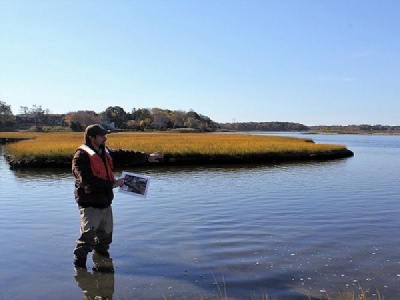
Posted on December 10, 2018
The U.S. Fish & Wildlife Service and The Nature Conservancy are working with partners to restore and strengthen salt-marsh habitat at the John H. Chafee National Wildlife Refuge. The project will enhance wildlife habitat and enable the marsh to withstand the impacts of sea-level rise and coastal storm surge. In addition, it will improve habitat for marine fish by enhancing the growth of eel grass.
This month crews are expected to position a barge and support boats in the lower Narrow River and begin dredging within a designated area, north of Sprague Bridge and east of Sedge Island. Seven hundred cubic yards of dredged material will be pumped toward the nearby shore, where it will be used to create new salt-marsh habitat in areas that have been lost to erosion in recent years. The foundation of the new marsh will be held in place by about 1,500 bags of recycled clam shells, which will be colonized by plants and invertebrate animals, according to project officials.
The work is scheduled to be completed by the end of the month. This marsh-creation technique was piloted at the Chafee National Wildlife Refuge in the winter of 2016-17, where it successfully halted the rapid deterioration of marshes on Sedge Island.
During the work period at the Chafee Refuge, boaters are urged to use caution and approach the equipment only at headway speed. The river access point on the north side of Sprague Bridge may be closed at certain points during dredging activities.
The work finishes a larger project focusing on 30 acres of marsh on the eastern shore of the Narrow River estuary, opposite Pettaquamscutt Cove. The work is being carried out under a $1.4 million, multiyear cooperative agreement between The Nature Conservancy and the Fish & Wildlife Service. More than a dozen federal, state, and local organizations came together to develop the restoration plan. It will contribute to a larger recovery effort funded in the wake of Hurricane Sandy to restore coastal and inland areas in 14 states from Virginia to Maine.
“[W]e’re working closely together to make Rhode Island a leader in piloting best practices for coastal resilience and adaptation to climate change,” said Scott Comings, associate state director for The Nature Conservancy. “The Chafee Refuge provides outstanding habitat for saltmarsh sparrows, egrets, black ducks, and many other water birds. The salt marshes on the refuge are irreplaceable natural resources.”
Salt marshes are adapted to tolerate periodic flooding, and they provide habitat for hundreds of species of plants, fish, shellfish, birds, and mammals. They also play a key role in cleaning and filtering stormwater, and act as a buffer against storm surge.
However, prolonged stretches of inundation will effectively suffocate a salt marsh, resulting in the die-off of critical fish and wildlife habitat. Healthy salt marshes are sometimes able to retreat slowly to slightly higher ground over time, colonizing adjacent areas as sea levels rise. At Chafee Refuge, however, the marsh is constrained by upland areas to the east, with little opportunity for migration.
The marsh restoration project at the Chafee Refuge is among 70 projects managed by the Fish & Wildlife Service through $167 million in federal funding for Hurricane Sandy recovery.
The Nature Conservancy has been working with partners to protect and restore wildlife habitat in the Narrow River watershed for more than 20 years.
The dredging contract was awarded to SumCo Eco-Contracting of Salem, Mass., through a competitive bidding process.
Source: ecoRI News





